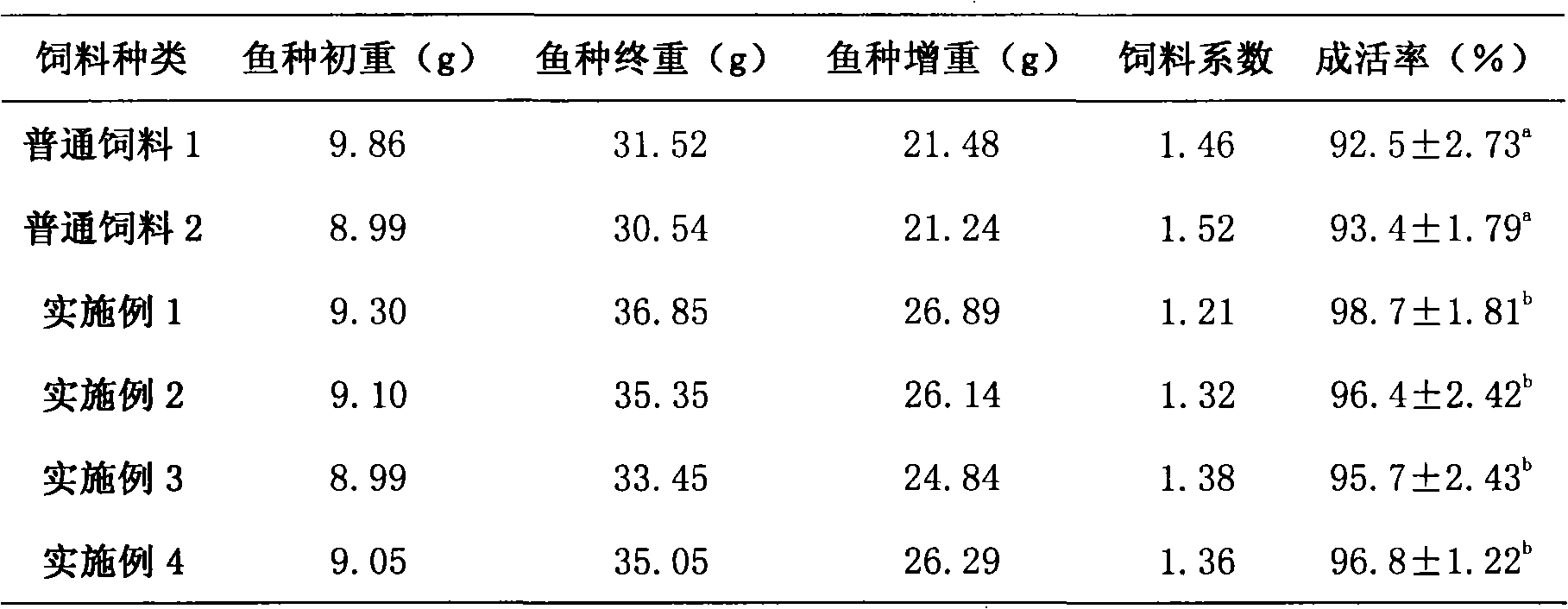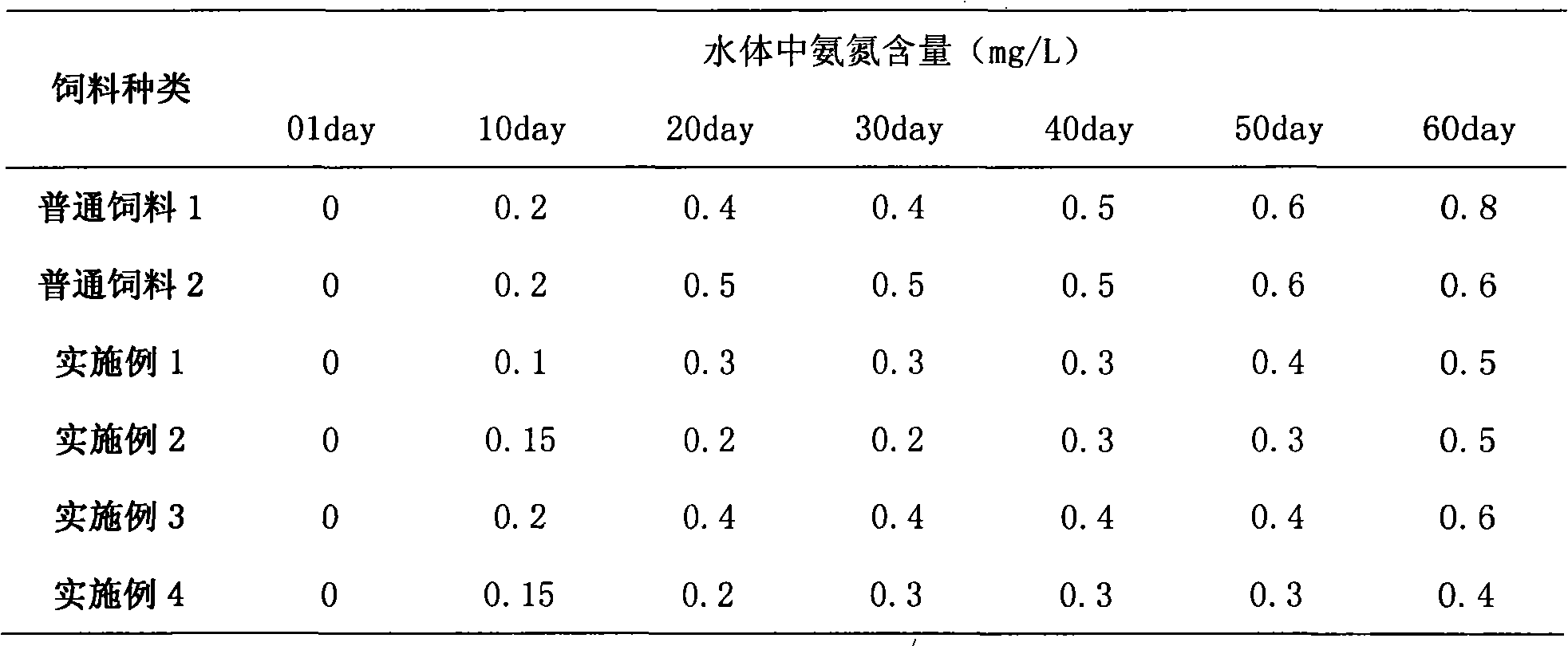Environmentally-friendly tilapia feed
An environment-friendly technology for tilapia, which is applied in the field of tilapia farming, can solve the problems of excessive ammonia nitrogen content, increasing the prevalence of tilapia, and making full use of nutrients to pollute the water body, so as to reduce the feed factor and increase fish The effect of improving body immunity and shortening the breeding cycle
- Summary
- Abstract
- Description
- Claims
- Application Information
AI Technical Summary
Problems solved by technology
Method used
Image
Examples
Embodiment 1
[0017] Environment-friendly type tilapia feed formula (percentage by weight) is as follows:
[0018] 30% soybean meal, 2% fish meal, 14% corn distillers grains, 16% rapeseed meal
[0019] Cottonseed Meal 5%, Rice Bran Meal 5%, Wheat Flour 22%, Fish Oil 2%
[0020] The remaining 4% are environmentally friendly additives, including 0.08% vitamin C, 0.7% multivitamin, 0.7% multimineral, 0.5% salt, 0.5% choline chloride, 1% calcium dihydrogen phosphate, 0.5% immune polysaccharide, allicin 0.01% and phytase 0.01%.
[0021] Among them, the content of each vitamin in the multivitamin is VA 5000000IU / kg, VD 2000000IU / kg, VE80000mg / kg, VK 10000mg / kg, VB1 10000mg / kg, VB2 5000mg / kg, VB6 10000mg / kg, pantothenic acid 50000mg / kg, niacin 21000mg / kg, biotin 100mg / kg, folic acid 5000mg / kg, inositol 40000mg / kg, VC 50000mg / kg, VB12 50mg / kg; the content of each element in the compound minerals is iron 15000mg / kg, zinc 20000mg / kg, magnesium 10000mg / kg, manganese 2000mg / kg, copper 1000mg / kg, iod...
Embodiment 2
[0025] Environment-friendly type tilapia feed formula (percentage by weight) is as follows:
[0026] 18% soybean meal, 5% fish meal, 14% corn distillers grains, 10% rapeseed meal
[0027] Cottonseed Meal 10%, Rice Bran Meal 12.5%, Wheat Flour 25%, Fish Oil 1%
[0028] The remaining 4.5% are environmental additives, including 0.08% vitamin C, 0.7% multivitamin, 1% multimineral, 0.5% salt, 0.6% choline chloride, 1% calcium dihydrogen phosphate, 0.6% immune polysaccharide, allicin 0.01% and phytase 0.01%.
[0029] Wherein, compound vitamin and compound mineral formula are all identical with embodiment 1.
[0030] The preparation method is the same as in Example 1.
[0031] The mass percentages of the feed detection indicators were determined to be 28% crude protein, 4.7% crude fat, 6.3% ash, and 9.8% moisture.
Embodiment 3
[0033] Environment-friendly type tilapia feed formula (percentage by weight) is as follows:
[0034] 15% soybean meal, 5% fish meal, 10% corn distiller's grains, 17% rapeseed meal
[0035] Cottonseed Meal 3%, Rice Bran Meal 10%, Wheat Flour 30%, Fish Oil 5%
[0036] The remaining 5% are environmental additives, including 0.08% vitamin C, 0.8% multivitamin, 1% multimineral, 0.8% salt, 0.65% choline chloride, 1% calcium dihydrogen phosphate, 0.63% immune polysaccharide, allicin 0.02% and phytase 0.02%.
[0037] Wherein, compound vitamin and compound mineral formula are all identical with embodiment 1.
[0038] The preparation method is the same as in Example 1.
[0039] It is determined that the mass percentages of the feed detection indicators are 26.1% crude protein, 8.1% crude fat, 5.8% ash, and 10.5% moisture.
PUM
 Login to View More
Login to View More Abstract
Description
Claims
Application Information
 Login to View More
Login to View More - R&D
- Intellectual Property
- Life Sciences
- Materials
- Tech Scout
- Unparalleled Data Quality
- Higher Quality Content
- 60% Fewer Hallucinations
Browse by: Latest US Patents, China's latest patents, Technical Efficacy Thesaurus, Application Domain, Technology Topic, Popular Technical Reports.
© 2025 PatSnap. All rights reserved.Legal|Privacy policy|Modern Slavery Act Transparency Statement|Sitemap|About US| Contact US: help@patsnap.com


